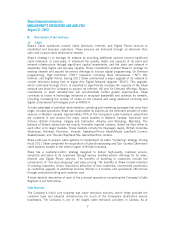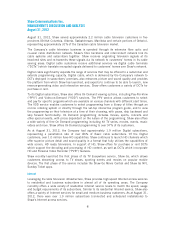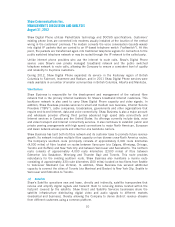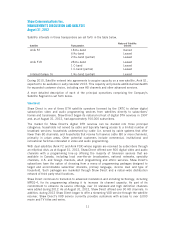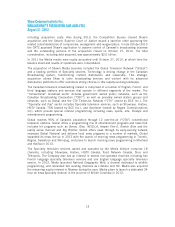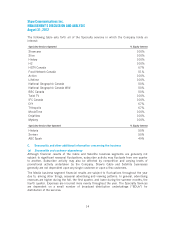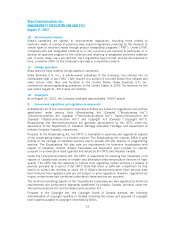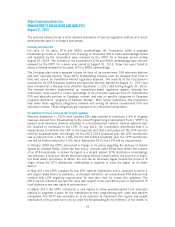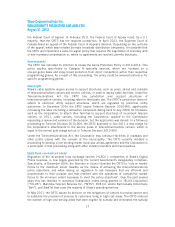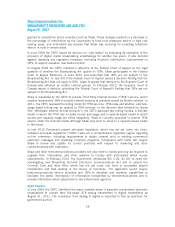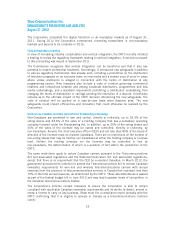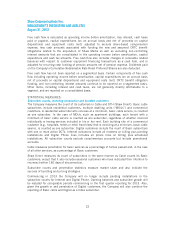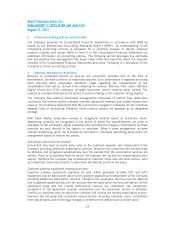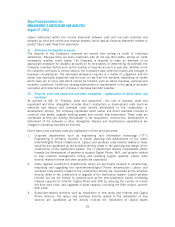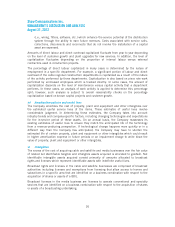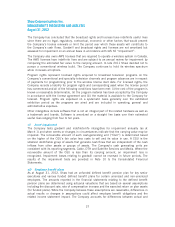Shaw 2012 Annual Report Download - page 21
Download and view the complete annual report
Please find page 21 of the 2012 Shaw annual report below. You can navigate through the pages in the report by either clicking on the pages listed below, or by using the keyword search tool below to find specific information within the annual report.Shaw Communications Inc.
MANAGEMENT’S DISCUSSION AND ANALYSIS
August 31, 2012
the Federal Court of Appeal. In February 2011 the Federal Court of Appeal ruled, by a 2-1
majority, that the CRTC has the required jurisdiction. In April 2012, the Supreme Court of
Canada heard an appeal of the Federal Court of Appeal’s decision. Depending on the outcome
of the appeal, which was initiated by major broadcast distribution companies, it is possible that
the CRTC will implement a value-for-signal policy that requires the negotiation of monetary and/
or non-monetary compensation or, where no agreements are reached, permits blackouts.
Genre exclusivity
The CRTC has indicated its intention to review the Genre Protection Policy in 2013-2014. This
policy applies specifically to Category A specialty services, which are licensed on a
one-per-genre basis and enjoy broad protection from direct competition within their respective
programming genres. As a result of this proceeding, the policy could be removed entirely or for
specific programming genres.
Access rights
Shaw’s cable systems require access to support structures, such as poles, strand and conduits
of telecommunication carriers and electric utilities, in order to deploy cable facilities. Under the
Telecommunications Act the CRTC has jurisdiction over support structures of
telecommunication carriers, including rates for third party use. The CRTC’s jurisdiction does not
extend to electrical utility support structures, which are regulated by provincial utility
authorities. In December 2010 the CRTC issued Telecom Decision 2010-900, significantly
increasing the rates (including a retroactive component dating back to July 2009) for licensees,
such as the Corporation, to attach their facilities to support structures of incumbent telecom
carriers. In 2011, cable carriers, including the Corporation, applied to the Commission
requesting a review and variance of the decision, but the application was denied. In a follow-up
proceeding to Telecom Decision 2010-900, the CRTC approved in July 2011 a new charge for
the Corporation’s attachments to the service poles of telecommunications carriers, which is
equal to the normal pole charge set out in Telecom Decision 2010-900.
Under the Telecommunications Act, the Corporation may construct facilities in roadways and
other public places with the consent of the municipality. The CRTC recently initiated a
proceeding to develop a non-binding model municipal access agreement and the Corporation is
a participant in that proceeding along with other industry members and municipalities.
Digital Phone, new media and Internet
Regulation of the incumbent local exchange carriers (“ILECs”), competitors of Shaw’s Digital
Phone business, is now largely governed by the current Government’s deregulatory initiatives.
Specifically, in December 2006, the Governor in Council directed the CRTC to “rely on market
forces to the maximum extent feasible as the means of achieving the telecommunications
policy objectives, and when relying on regulation to use measures that are efficient and
proportionate to their purpose and that interfere with the operations of competitive market
forces to the minimum extent necessary to meet the policy objectives”. Over the past several
years this has resulted in numerous forbearance orders being granted to TELUS Corporation
(“TELUS”), Manitoba Telecom Services Inc. (“MTS”), BCE Inc. and/or Bell Canada (collectively
“Bell”), and SaskTel that cover the majority of Shaw’s operating territory.
In May 2011, the CRTC issued its decision on the obligations of carriers to provide service and
to subsidize the provision of services to customers living in high cost areas. The CRTC reduced
the number of high-cost serving areas that were eligible for subsidy and eliminated the subsidy
17


